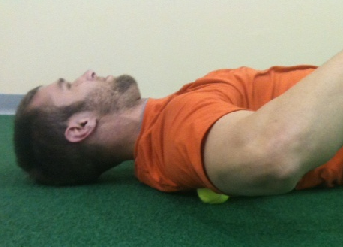
by David Rosales
Over the last two decades, foam rolling has gone from an obscure, strange protocol to a staple of the commercial gym.
Foam rollers have been, rightfully, billed as a form of myofascial release, like a massage, but without the cost or inconvenience of going to a masseuse.
However, foam rollers, even though they’re often expensive considering they’re just pieces of foam, rarely are the best tool to accomplish this.
That’s for a few reasons.
While many fitness experts have denounced foam rolling, when you take a close look at the controversy, most experts think that foam rolling, just like massage, has benefits as long as you do it with a purpose.
Foam rolling is a waste of time if you mindlessly move back and forth while “doomscrolling” on your phone.
By choosing the right tool, we can be more intentional with our myofascial release, and make it more effective.
Understanding “Trigger Points”
In The Trigger Point Therapy Workbook by Clear and Amber Davies, they define a knotted-up group of muscle fibers as a “trigger point.” More specifically, when the actin and myosin fibers in the muscle remain stuck in a contracted position.
These trigger points affect the function of the whole muscle. A muscle that’s filled with trigger points won’t move through a full range of motion, nor will it be able to maximally contract. Of course, if we’re exercising we want to improve both of these.
When we do self-myofascial release, we should target small areas of knots, or trigger points. To do this most effectively, it requires a smaller, more targeted tool.
Here are 3 alternatives to a foam roller that you may already have laying around your house, and how to use them to prevent injuries and improve performance.
They’re also easy to throw in a gym back and to bring with you traveling.
If you don’t have them, they won’t cost you more than a few bucks (or pennies).
1) Tennis Ball
A tennis ball is the simplest and most versatile place to start. From your glutes, to your calves, to the pectoral muscles, a tennis ball can sneak into trigger points that a roller can’t.
We have an entire article on self-myofascial release with a tennis ball, so I won’t go too deep into its versatility and uses.
To add to it, the “side glute” muscles, the gluteus minimus and gluteus medius, often contain trigger points that the tennis ball can easily target.
If you touch the side of your hip bone, and then move an inch or two lower, you’ll be touching these muscles. By laying on your side with the ball in that position, you can target those trigger points.
This is another area that’s much more effectively released using a tennis ball compared to a foam roller.
2) Lacrosse Ball or Baseball
One of the benefits of foam rollers is that they come in various difficulties. You can find rock-hard foam rollers on the market for those who are used to self-myofascial release and need more resistance.
One of the critiques of the tennis ball is that it’s not firm enough to challenge tough trigger points, muscle groups, or experienced users.
Think of lacrosse balls or baseballs as the level 2 version of the tennis ball.
Between the two, the lacrosse ball is a little smaller, and when they’re new, the rubber cover makes it easier to keep the ball on the muscle.
However, as they get older, this rubber layer smooths out, and the ball can slide right off the muscles. This doesn’t happen with a baseball. However, the laces on the baseball may leave temporary marks, so be aware of that.
If you already have either of these around the house, either will work.
3) Softball
The critique of our previous options is that they’re too small to target bigger muscle groups like the quads and lats.
That’s where the softball can come in. In fact, the softball is large enough to target these muscles, but still small enough for other muscle groups, making it the ideal choice if you can only use one.
The softball also hits large muscles like hte quads and lats in more targeted ways than a roller.
Often the roller is fine for the quads or lats broadly, but when we know they have a specific trigger point, the softball is much better.
This allows us to achieve our goals with self-myofascial release: to relive these knotted up areas which leads to injuries and decreased performance.
When I was the strength and conditioning coach of a Junior hockey program, I had a very small equipment budget. I knew the value of effective myofascial release, but instead of buying rollers, I found an old bucket of softballs for a few dollars on craigslist. An entire bucket, enough for a whole team to do myofascial release at once, cost less than a new foam roller.
With just the softballs, we can hit all of our self-massage targets.
What About Myofascial Release Products?
There are tons of fancy tools you can buy that are ball-like, or rollers with spikes or unique shapes. The cost rarely makes sense, and they’re often not better than these tools. Even if they are, it’s a marginal difference.
The only exception is the electric massage guns, which may be a good investment if it’ll get you to practice myofascial release more often, like while watching TV, when it’s impractical to lay down and use another tool.
However these run hundreds of dollars, so it’s a big investment.
Elite Health And Performance Doesn’t Cost a Fortune
For the time and effort required, self-myofascial release is one of the best tools at our disposal for health and performance. That’s especially if you make it a habit, which you can with a few simple strategies to build habits. Professional teams in almost all major sports include it in their strength and conditioning programs on a near-daily basis because it’s so effective.
And in many of these organizations, you’ll still see tennis balls and lacrosse balls. Cost is not a barrier to the benefits. So scour your house, find a tennis ball or baseball, and you’ve just found a tool that can provide you the benefits of thousands of dollars worth of massage.

(David Rosales is a writer and NSCA-Certified Personal Trainer. He’s the co-owner of Roman Fitness Systems, and has worked with athletes and coaches from beginners all the way up to NCAA Division 1 and professional ice hockey. Originally from Vermont, David lives in New York City. He loves books, pop-punk music, Vermont maple syrup, and heavy split squats.)


Be the first to comment